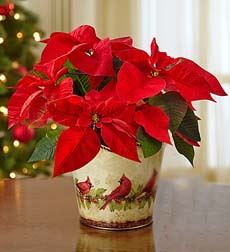FOOD FUN: Poinsettia Hors d’Oeuvre
|
Turn spinach dip into poinsettia hors d’oeuvre.
The ones in the top photo, from Mackenzie Limited. They have a base of focaccia bread topped with creamy spinach dip with a hint of truffle oil. The flower is made from piped goat cheese flower. We created our own version of the canapés, which pair well with beer, wine or a savory Martini. They are best assembled as close as possible to serving time, although you can prepare the spread and other ingredients in advance. RECIPE: POINSETTIA CANAPÉS Ingredients 1. CUT the bread into rounds with a 1-1/2″ cookie cutter and top with some of the spread. Place on a serving tray. 2. PIPE five petals on top of each and add the red center. A canapé (can-uh-PAY) is a type of hors d’oeuvre: a small, savory bite on a base of bread, pastry, toast or a cracker. It is cocktail party fare, a finger food eaten in one or two bites. |

[1] White poinsettia goat cheese blossoms atop a spinach and foccaccia base (photo courtesy Mackenzie Ltd.). [2] This version uses roasted red peppers to create the flower and fresh thyme leaves and flowers for the center (photo courtesy Tara’s Table caterers). |
|
|
Canapé is the French word for sofa. The idea is that the toppings sit on a “sofa” of bread or pastry. In the hands of a good caterer or chef, they can be beautifully decorated works of edible art. The translation of “hors d’oeuvre” means “[dishes] outside the work” i.e., outside the main meal. Technically, the term “hors d’oeuvre” refers to small, individual food items that have been prepared by a cook. Beyond canapés, hors d’oeuvre include everything from deviled eggs and crab puffs to mini-quiches to rumaki (bacon-wrapped dates). There are scores of options in French cuisine alone. |
||
 A poinsettia plant (photo courtesy 1-800-Flowers). |
ABOUT THE POINSETTIA PLANT
Native to southern Mexico, what we call the poinsettia (Euphorbia pulcherrima) was used for dye and decorative purposes by the Aztecs. The milky white sap, today called latex, was made into a preparation to treat fevers. Cuetlaxochitl, the Aztec name for the plant, is actually a small tree. It was bred down to a tabletop plant, although you may still come across a lovely small tree at better florists. In Mexico, it blooms naturally in Mexico around Christmastime. The poinsettia achieved fame in the U.S. thanks to Joel Roberts Poinsett, the first U.S. Ambassador to Mexico (1825-1829), who had been a member of the U.S. House of Representatives. An amateur botanist, he sent spectacular plant to botanist colleagues in the U.S. for breeding. It became known as the poinsettia (try pronouncing cuetlaxochitl). Its vibrant red color made it a natural for holiday decorations, and it was subsequently bred into pink and white varieties as well. |
|
|
Ambassador Poinsett later served as Secretary of War under Martin Van Buren, and was a co-founder of the National Institute for the Promotion of Science and the Useful Arts, a predecessor of the Smithsonian Institution). Note that his name is Poinsett, not Pointsett; there is no “pointsettia” plant. Congress honored Joel Poinsett by declaring December 12th as National Poinsettia Day. |
||



